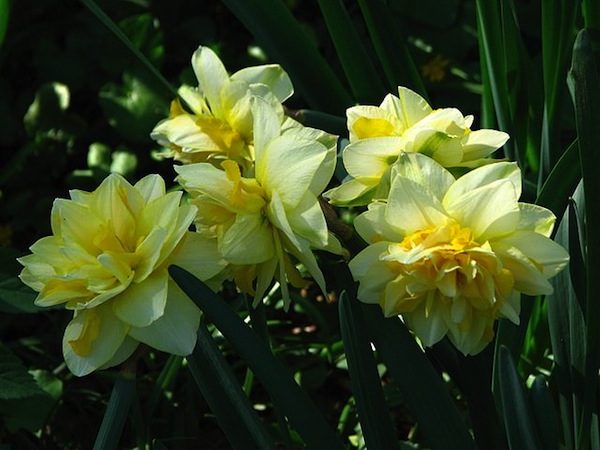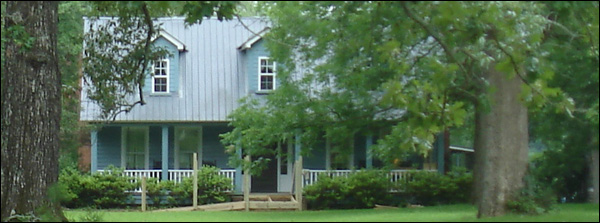Lamentation, Then Spring
“Here am I, humbled by the forces to which even I must submit, admonished to get about doing the things that must be done.”—William A. Balk, Jr.
Epicurus’ Porch
By William A. Balk, Jr.

 BEAUFORT South Carolina—(Weekly Hubris)—3/17/2014—Gardeners are always relearning how to face disappointment and destruction. Sometimes, it is the havoc wreaked by a massive hatch of the potato beetle larvae (Leptinotarsa decemlineata), which can strip a row of potato plants or other solanaceous plants like tomatoes and eggplants, leaving bare stalks unable to produce a crop. Sometimes it is a particularly wet summer, encouraging fungal growth like black spot on roses, or downy mildew on dozens of garden lovelies. And sometimes, as we here in the upper Low Country of South Carolina have very recently experienced, it is historic cold temperatures followed by premature spring warmth, followed by devastating ice storms, which felled limbs and trees and flattened old, established plantings.
BEAUFORT South Carolina—(Weekly Hubris)—3/17/2014—Gardeners are always relearning how to face disappointment and destruction. Sometimes, it is the havoc wreaked by a massive hatch of the potato beetle larvae (Leptinotarsa decemlineata), which can strip a row of potato plants or other solanaceous plants like tomatoes and eggplants, leaving bare stalks unable to produce a crop. Sometimes it is a particularly wet summer, encouraging fungal growth like black spot on roses, or downy mildew on dozens of garden lovelies. And sometimes, as we here in the upper Low Country of South Carolina have very recently experienced, it is historic cold temperatures followed by premature spring warmth, followed by devastating ice storms, which felled limbs and trees and flattened old, established plantings.
During a week without light or heat or water early in the year, I found I was as capable of beating my breast and crying woe-is-me as Ophelia, especially when the extent of the damage to the ten acres of longleaf pine (Pinus palustris) became obvious. After a similar ice storm nearly a decade ago—a storm which destroyed a similar planting of loblolly pine (Pinus taeda) which itself had grown for ten years—my late father had planted the slower maturing longleafs so that later generations of his progeny might benefit from the magnificent timber to be harvested some five decades hence.
Farmers of other crops will think in terms of weeks, or seasons, or perhaps even years. Tree farmers must think in terms of decades or lifetimes. The February ice storm ended nearly two decades of my father’s efforts to provide beauty, ecological health, and financial security on this parcel of his land.
It was after the ice had melted and the power come back on, as I was contemplating courses of action to mitigate the damage, that I read my new copy of “The Mediterranean Garden,” published by the Mediterranean Garden Society, which is headquartered in Greece. The journal is published four times a year; both the journal and the Society offer excellent horticultural insights, history, wonderful writing, and access to archives and gardens all over the Mediterranean—a point of interest for those of us hoping to learn about the sources for many of our own garden plants.
In January’s issue, I was completely engaged by a wonderful article by the writer E. Kirsten Honeyman on a garden in Provence, an ancient property in the medieval hilltop village of Ménerbes. The castle, called La Carmajane, has been magnificently restored, and major attention has been given to the gardens on the grand hillside terraces.
The new owners of the property faced their own disaster before taking possession of it. In 1993, a period of constant hard rains saturated the earth in the upper level gardens. A thousand-ton boulder which had supported the massive walls of the upper terraces was dislodged, falling below and washing downhill a major part of the terraced garden above.
It was Honeyman’s description of the next stage at La Carmajane that made me reconsider my own horticultural misery. The new owners quickly realized that they had a clean slate to begin rebuilding the upper terrace garden, and they began in earnest. Over the next several years, with the aid of brilliant designers and talented workmen, the current gardens were completed and La Carmajane is now a world-class destination garden.
I know, of course, that our humble farmland is no Provençal castle. Nor does it aspire to be visited by crowds of tourists. I certainly realized, however, that the damage we face this spring can also be overcome—certainly if the owners of La Carmajane can repair such ruin as they faced, we can develop ways to make our property whole again.
It is fortunate that Nature herself takes only a little notice of such disasters. While I am still somewhat flummoxed trying to decide how we can remove the hundreds of broken, hanging limbs among the old live oaks and pecans and sweetgums (Liquidamber styraciflua) on the grounds of the house, those very trees are showing their bright green new buds. It will be weeks or months before dangling limbs are dealt with but, by that time, the trees will have sent vigorous new growth to replace that which was lost.
Already, the old pear tree near the front door is in full bloom. Over its long life in that spot, it has withstood loss of limbs, devastating freezes, burning summer heat, countless children clambering over it, and it still produces delicious fruit most years. This is the Kieffer pear, also locally called a sand pear, which is a hybrid between the soft European pear (Pyrus communis) and the Asian pear (Pyrus pyrifolia); its fruit is hard at maturity, ideal for canning or cooking. Its two sister trees in the back yard are not so precocious, still only barely showing a little growth at branch tips.
Even as the ice was melting (the five acres of the grounds looked like it had snowed; in fact it was a layer of sleet an inch and a half thick), inspiring signs of Spring tentatively appeared. There are narcissus scattered haphazardly throughout the yard next to trees, in the middle of the lawn, one or two even appearing in a flower border. I suspect as many have been transplanted by the pestilential grey squirrels as by generations of gardeners.
The earliest to bloom this year is a bizarre, fully-double, pale yellow flower, whose unopened buds look round and fat enough to explode. The opened flower has no trumpet but, rather, the whole effect is of a shredded, over-filled daffodil. Plant maven Alice Massey suggested it may be the old-fashioned “Butter and Eggs” variety, and that’s about as close as I’ve found to describing its appearance. Several days later, a couple of tazettas opened up, then the jonquillas. The weather certainly didn’t give any of these pause in their schedule.

Sometimes, in crisis, I seem to forget the obvious. I had worried during the worst of the storms and the freezes about the standard garden plants: the camellias, the hydrangeas, the roses; magnolias, chrysanthemums, maples, hemerocallis. These plants have survived—even thrived—forever, it seems, even in weather like our recent winter. My tentative, nervous inspection shortly after things warmed up a bit told me that I am still overly delicate, while they are determinedly, defiantly, too busy getting on with the business of growing.
The ten-foot-tall and wide camellias were flattened to the ground by the ice. Within days, they had righted themselves perfectly; out of dozens of camellias, I had one broken branch.The roses (I have a couple of hybrid teas which do go mostly dormant during the winter; and several wonderful hybrids of the China rose, which will continue to grow through the winter) showed no effect at all from the storms’ intensity. The hydrangeas looked really awful, even though they never bent or broke under the weight of the ice. But my first cut of a long branch showed undamaged green phloem beneath the dry-brown bark, ready to produce new spring growth. We may get fewer flowers from them this year, but the plants are healthy.
The tough garden chrysanthemums are making luscious little mounds of leaves, utterly unfazed by the cold. The daylilies were growing unhindered even in the covering ice, even the ones in pots, even those which had frozen solid in their pots weeks before.
Not everything, however, went unaffected by the weather. I love growing tender tropical plants. There are always a few orchids, several flowering cacti (Schlumbergera sp. and Epiphyllum x), and bird’s nest ferns (Asplenium nidus), which I have to overwinter on the enclosed back porch or in my new little plastic-covered, heated greenhouse. January’s deep, hard freeze severely hurt most of these, despite the heater. The ice storm, however, cut off the power to the heater and broke off a limb from a nearby pecan tree. The cold, the wind, the big hole in the cover, and the lack of heat turned almost everything to black mush. By the time I discovered this, I was already numb from the other damage and by the immediate need of keeping ourselves warm and safe, so I cannot say the discovery was devastating. Just disappointing.
Nevertheless, even here the annual miracle that is Spring can bring wonder and delight to a pained soul. On a visit to the ripped greenhouse in the last few days, there were small signs of hope.
The nun’s orchid (Phaius tankervilliae), a cherished gift, has new green coloring at the base of the now blackened sword leaves. Several of the orchid-flowering cacti had small sections undamaged. The bird’s nest ferns all have severely browned leaves, but most seem to have new growth from the centers. Frankly, such toughness is inconceivable to me: these are not conditions such plants are meant to survive. Yet, there they are . . .
And here am I, a gardener who wasted time cursing Nature’s own ways, faithless of her inexorable cycles. Here am I, grinning with pleasure at the discovery of an unshed, still-living red leaf on a young Hydrangea quercifolia. Here am I, humbled by the forces to which even I must submit, admonished to get about doing the things that can, and must be done, reminded that my little quibbles and infirmities are distractions. There is work to do. There are things to learn. What I can’t finish will be taken up or discarded as Nature requires. Spring is here.

6 Comments
Mary Laura Jones
Awesome! As always. And absolutely a joy to talk with you. I really want to drive down and visit the farm some year when I am in SC.
Your writing is a great gift, Mary Laura
Will
Thanks, MLJ….it is wonderful to talk with you again after … OMG! 45 years! Would love to see you.
diana
Very moving description of a gardener’s ups and downs, Will, excellent as usual. And so pleased to see the reference to the MGS journal, which I haven’t even read yet. Wishing you a healing spring. Warmly, d
Will
Thanks, Diana…..(by the way, there is a tiny community five miles from the farm called Healing Springs…the waters have been used curatively since before white men came on the scene. The last human owner of the acre around the springs recorded a deed giving title and ownership to “God”). It’s a very good issue of the Journal, but as I go back into the archives, I find that the standard is for fine writing and excellent subjects. I’m so pleased to be a member of the Society!
Lolita
Thank you Will, for once again shining a light on our gray, dismal world…I’ve been in despair to see shoots of poison ivy which put certain parts of my yard off-limits until the next cold snap (hopefully, next year!!)…and I’d love to have a conversation about your tree-planting philosophy..I too have some timber lands that need replanting but hate to go for the “short-term” solution…anyway, my friend, I wish you a wonderful Spring!!
Will
Lolita! It’s great to hear from you. We’ll talk trees next time we’re in the same space!